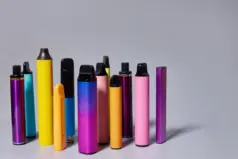
Disposable e-cigarettes have gone from being unwanted to a huge success for vape manufacturers. The United Kingdom embraced them with open arms due to the simplicity of use and advances in coil technology. But what happens when people have finished using them? Waste management experts are concerned.
Some companies in the electronic cigarette sector are reporting up to a 279% increase in disposable ecig product sales over the final quarter of 2021. Predict market growth for the disposable segment of the vape market this year is predicted to be a further 320% compound annual growth rate (CAGR). It is safe to say that disposable vapes are booming in the United Kingdom.
But levels of success can be measured away from balance sheets and order books. One leading disposable ecig brand has reached almost a billion views on TikTok, but this success comes with problems. Thanks to some disreputable vendors, 1 in 3 of another leading manufacturer’s disposable products currently being sold are counterfeit, but it’s the fact that Brits are throwing two disposable ecigs into a bin every second that should give pause for thought.
Disposal of the disposables is a vexing matter – especially for the Waste Electrical and Electronic Equipment recycling (WEEE) specialists. Recent reports estimate that we are throwing away three million of every week.
Disposable vapes contain unspent e-liquid (mildly toxic to the environment), a coil (quite toxic to the environment, single-use plastic (very toxic to the environment) and a lithium-ion battery (exceptionally toxic to the environment).
Disposable ecigs are classified as WEEE devices by law and experts are concerned that the term ‘disposable’ makes people think they can be thrown away with the rest of the rubbish. The recycling experts say the vapes are adding to the current 8% of electrical waste that is mistakenly added to regular household waste.
Experts say that there is an environmental risk posed by the low levels of lead, mercury, and cadmium contained within the products because of the high volumes of devices being dumped. Also, lithium is an exceptionally valuable commodity – powering everything from phones and laptops to the new generation of electric vehicles. They estimate that this is currently costing the UK £370 million per annum and is set to grow.
On top of this, lithium-ion batteries are blamed for 48% of fires that break out at recycling centres, accounting for about 600 individual fires and diverting fire services.
Wardell Armstrong, a multidisciplinary Environmental, Engineering and Mining consultancy, believes: “The recent rise in popularity of e-cigarettes presents a significant opportunity to explore methods of improving small WEEE recycling rates. To do this, not only must producers ensure devices are easy to recycle, but consumers must also have convenient access to the right recycling channels.”
The first step is to consider treating your throwaway vape like regular and rechargeable batteries by storing them and taking a box marked “e-Waste” full to your local recycling site. Is this something you would consider?
